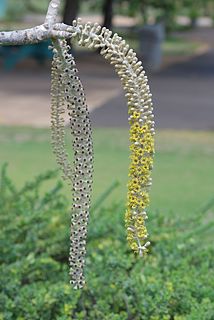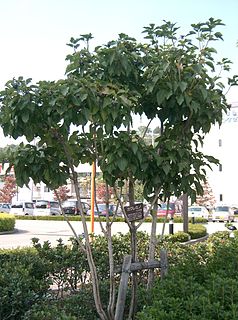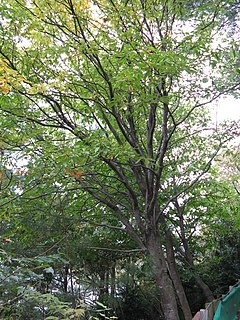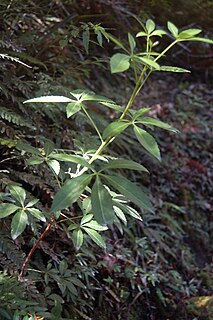
The Araliaceae are a family of flowering plants composed of about 43 genera and around 1500 species consisting of primarily woody plants and some herbaceous plants. The morphology of Araliaceae varies widely, but it is predominantly distinguishable based on its woody habit, tropical distribution, and the presence of simple umbels.

Aralia, or spikenard, is a genus of the family Araliaceae, consisting of 68 accepted species of deciduous or evergreen trees, shrubs, and rhizomatous herbaceous perennials. The genus is native to Asia and the Americas, with most species occurring in mountain woodlands. Aralia plants vary in size, with some herbaceous species only reaching 50 centimetres (20 in) tall, while some are trees growing to 20 metres (66 ft) tall.

GastoniaCommerson ex Lamarck is a formerly accepted genus of flowering plants in the ivy and ginseng family, Araliaceae. It had been known as an unnatural group, but was recognized as late as 2010, when its nine species were distributed to four different subgenera of the large genus Polyscias. Because the genus Gastonia is now obsolete, its species are herein referred to by their names in Polyscias.
Michel Félix Dunal was a French botanist. He was a professor of botany in Montpellier, France.

Schefflera is a genus of flowering plants in the family Araliaceae. With an estimated 600–900 species, the genus represents about half of its family. The plants are trees, shrubs or lianas, growing 4–20 metres (13–66 ft) tall, with woody stems, the absence of articulated pedicels and armaments, and palmately compound leaves.
Hermann August Theodor Harms was a German taxonomist and botanist.

Polyscias racemosa, or false 'ohe, is a species of flowering plant in the family Araliaceae. As Munroidendron racemosum, the species was until recently considered to be the only species in the monotypic genus Munroidendron. With the change in classification, Munroidendron is now obsolete. Polyscias racemosa is endemic to the Hawaiian island of Kauai. It is very rare in the wild and some of its original habitat has been replaced by sugar cane plantations. It was thought for some time to be probably extinct, but was rediscovered a few years prior to 1967.

Alangium is a small genus of flowering plants. The genus is included either in a broad view of the dogwood family Cornaceae, or as the sole member of its own family Alangiaceae. Alangium has about 40 species, but some of the species boundaries are not entirely clear. The type species for Alangium is Alangium decapetalum, which is now treated as a subspecies of Alangium salviifolium. All of the species are shrubs or small trees, except the liana Alangium kwangsiense. A. chinense, A. platanifolium, and A. salviifolium are known in cultivation.

Dendropanax is a genus of flowering plants in the family Araliaceae, consisting of 92 species of evergreen trees and shrubs, first described by Joseph Decaisne & Jules Émile Planchon in 1854. They are native to Central and South America, eastern Asia and the Malay Peninsula. Species such as Dendropanax trifidus or "kakuremino" in Japanese, are used in roji gardens, traditional moist and mossy areas leading to the chashitsu for tea ceremonies.
Arthrophyllum is a defunct genus of flowering plants in the family Araliaceae. It was recognized by most authors until 2010, when all of its 30 species were "sunk" into Polyscias subgenus Arthrophyllum.
Cuphocarpus is an obsolete genus of flowering plants in the family Araliaceae. Mabberley (2008) treated it as a synonym of Polyscias, but other authors still recognized it at that time. In 2010, in a phylogenetic analysis of DNA sequences, it was shown that Cuphocarpus was biphyletic and embedded in the large genus Polyscias. In an accompanying paper, Polyscias was divided into 11 subgenera, with seven species left incertae sedis.

Gamblea is a genus of plants of the family Araliaceae, comprising four species. It originally comprised a single species, Gamblea ciliata, which is found in India.
Merrilliopanax is a genus of flowering plants in the family Araliaceae, comprising 3 species of the subgenus Airampora. They are found in western China, Myanmar, northeast India, Bhutan, and Nepal.

Raukaua is a genus of flowering plants in the family Araliaceae. It has an austral distribution, being indigenous to southern Argentina and Chile, as well as New Zealand and the island of Tasmania.
Reynoldsia is an obsolete genus of flowering plants in the ivy family, Araliaceae. In 2003, Kew Gardens published a checklist for Araliaceae, in which eight species were recognized for Reynoldsia: four from Samoa, two from Tahiti, one from the Marquesas, and one from Hawaii. In 2010, a phylogenetic comparison of DNA data showed that Reynoldsia was polyphyletic, consisting of two groups that are not each other's closest relatives. In a companion paper, three of the species were "sunk" into synonymy with others, reducing the number of species to five. All species that were formerly in Reynoldsia are now in ''Polyscias'' subgenus Tetraplasandra, a subgenus of 21 species indigenous to Malesia and Pacific islands.
Tetraplasandra is an obsolete genus of flowering plants in the ivy family, Araliaceae. They are small to medium trees, of mesic to wet forests.
Tyleropappus is a genus of flowering plants belonging to the family Asteraceae. It just contains one species, Tyleropappus dichotomusGreenm. ex Gleason
Harmsiopanax ingens of the Gensing, or Ivy Family (Araliaceae), is a very spiney palmlike mesocaul tree endemic to the montane rainforests of central New Guinea which bears a terminal rosette of deeply lobed, meter-wide dentate margined, peltate leaves on equally long petioles. It ultimately attains a height of eighteen meters, at which point it bears a huge panicle of flowers five meters high and equally wide; the largest above ground inflorescence of any dicot plant (although Caloncoba flagelliflora and Ficus geocarpa and Ficus unciata var. strigosa have larger subsurface panicles, each about nine meters in length. H. ingens' panicles are very unusual; the ultimate twigs being spikes each bearing about fifty tiny umbels, each umbel with 8 to 20 minute flowers. So panicle, spike and umbel are all represented in a single inflorescence. Harmsiopanax ingens is monocarpic, and again the largest such plant among dicots. H. ingens was discovered in 1973 by W. R. Philipson. Its native name is "makua".

Schubertia is a genus of flowering plants in the family Apocynaceae, first described as a genus in 1810. It is native to South America.
Shiuyinghua is a monotypic genus of flowering plants belonging to the family Paulowniaceae. The only species is Shiuyinghua silvestrii.








